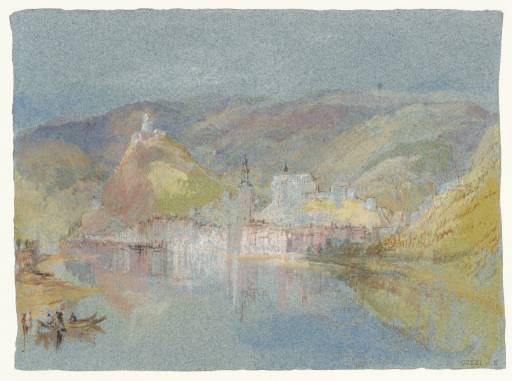Joseph Mallord William Turner Cochem from the North c.1839
Joseph Mallord William Turner,
Cochem from the North
c.1839
Joseph Mallord William Turner 1775–1851
Cochem from the North c.1839
D20238
Turner Bequest CCXXI E
Turner Bequest CCXXI E
Gouache and watercolour on blue wove paper, 140 x 190 mm
Blind-stamped with Turner Bequest monogram bottom right
Stamped in black ‘CCXXI E’ bottom right
Blind-stamped with Turner Bequest monogram bottom right
Stamped in black ‘CCXXI E’ bottom right
Accepted by the nation as part of the Turner Bequest 1856
Exhibition history
1904
National Gallery, London, various dates to at least 1904 (178, as ‘Rhine?’).
1982
J.M.W. Turner Watercolors from the British Museum, Georgia Museum of Art, University of Georgia, Athens, March–May 1982, Museum of Fine Arts, Houston, May–July 1982 (42, reproduced as A Town on the Moselle?).
1991
Turner’s Rivers of Europe: The Rhine, Meuse and Mosel, Tate Gallery, London, September 1991–January 1992, Musée Communal d’Ixelles, Brussels, February–April 1992 (67, reproduced).
1995
Turner in Germany, Tate Gallery, London, May–September 1995, Städtische Kunsthalle Mannheim, September 1995–January 1996, Hamburger Kunsthalle, Hamburg, January–March 1996 (55, reproduced in colour).
References
1904
E.T. Cook and Alexander Wedderburn eds., Library Edition: The Works of John Ruskin: Volume XIII: Turner: The Harbours of England; Catalogues and Notes, London 1904, pp.386, 615 no.178, as ‘Rhine?’.
1909
A.J. Finberg, A Complete Inventory of the Drawings of the Turner Bequest, London 1909, vol.II, p.688, as ‘Castle on rock. Probably Moselle.’.
1982
Lindsay Stainton and Richard S. Schneiderman, J.M.W. Turner Watercolors from the British Museum, exhibition catalogue, Georgia Museum of Art, University of Georgia, Athens 1982, p.55.
1984
Gérard Thill, Jean-Claude Muller and Jean Luc Koltz, J.M.W. Turner in Luxembourg and its neighbourhood, exhibition catalogue, Musée de l’Etat, Luxembourg 1984, p.109 no.43.
1991
Cecilia Powell, Turner’s Rivers of Europe: The Rhine, Meuse and Mosel, exhibition catalogue, Tate Gallery, London 1991, pp.129 no.46, 142, 143 no.67, reproduced.
1995
Cecilia Powell, Turner in Germany, exhibition catalogue, Tate Gallery, London 1995, pp.61, 64; 132 no.52, 135 no.55 reproduced in colour, 149 no.73.
1995
Cecilia Powell and Pia Müller-Tamm, William Turner in Deutschland, exhibition catalogue, [Städtische] Kunsthalle Mannheim 1995, p.154 no.55 reproduced in colour.
This view of Cochem is related to two pencil drawings in the last of Turner’s five 1839 sketchbooks (Tate D28547–D28548; Turner Bequest CCXCI 6–6a). The artist shows the town from downstream, incorporating, at right, the break in the Moselle valley which signals the source of the River Endert.
Cochem is overlooked by the ruins of the Castle Reichsburg seen in this drawing atop the conical mount to the left. There is a tiny chapel visible near the base of the mount called the Pestkapelle St Rochus (the Plague Chapel of St Roch). At centre is the tower of Saint Martin’s Church rising loftily above a tight nucleus of houses and buildings. Behind the church, and on a higher ridge, is the seventeenth-century Capuchin monastery.
Cochem is pictured here, as Michael Joseph Quin, the Irish travel writer quipped, cradled by ‘piles of mountains’.1 Some peaks, he writes, are ‘tabled at the top’, with ‘some descending in waving lines until they are lost in the azure distance’.2 Quin praises Cochem as ‘a picture of natural fertility, and of human industry carried to one of the highest practicable degrees of perfection, diversified by bold escarpments of naked rocks, and by eminences covered with brambles’.3
For Quin, the Reichsburg Castle immediately suggests to the traveller the historical ‘importance formerly attached to Cocheim’ as an Imperial town once occupied by Konrad III, the first King of Germany.4 Turner renders the Reichsburg gleaming with minute flecks of pearl-white gouache, echoing pictorially Quin’s textual description of its ‘bleached battlements’, which, ‘when illumined by the sun... shine out with the lustre of burnished steel armour’.5 And the St Roch Chapel, Quin further writes, imparts an ‘air of sanctity, as the castle does of chivalry’ to the visitor’s picture of Cochem.6
The town itself, Quin notes:
has always been of some consequence... Almost every house is engaged in trade, its principal commerce being in the prime wines of its vicinity, in linens, groceries, and iron. It has all the appearance of being a busy and prosperous town, and carries considerable trade with Coblenz, Frankfort [sic] on the Maine, and several places on the banks of the Moselle.7
While Turner’s picture briefly references this local commerce with the inclusion of boatmen in the foreground loading their vessel with goods, he has removed much sense of industry and commerce here. Cochem appears a picture of serenity, bathed in radiant and tranquil light.
Michael Joseph Quin, Steam voyages on the Seine, the Moselle, & the Rhine: with railroad visits to the principal cities of Belgium, London 1843, p.48; see also ‘Historie’, Burg Cochem, accessed 21 July 2014, http://www.burg-cochem.de/26.html
Verso:
Stamped in black with Turner Bequest monogram and ‘CCXXI. E’ bottom centre; inscribed in pencil ‘CCXXI. E’ at centre towards bottom, ‘13a’ at centre and ‘29b’ at centre towards right.
Alice Rylance-Watson
September 2013
How to cite
Alice Rylance-Watson, ‘Cochem from the North c.1839 by Joseph Mallord William Turner’, catalogue entry, September 2013, in David Blayney Brown (ed.), J.M.W. Turner: Sketchbooks, Drawings and Watercolours, Tate Research Publication, November 2014, https://www

